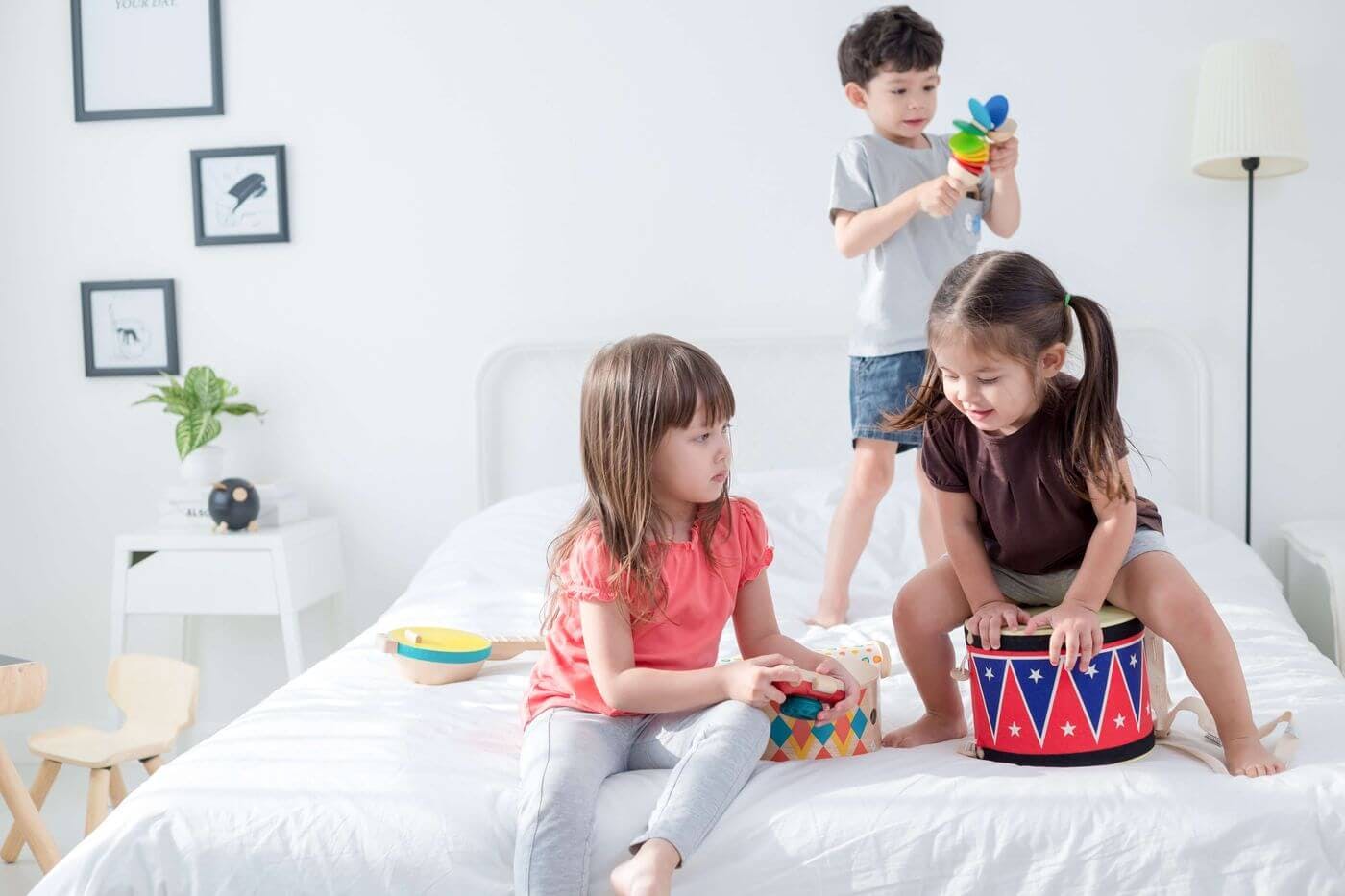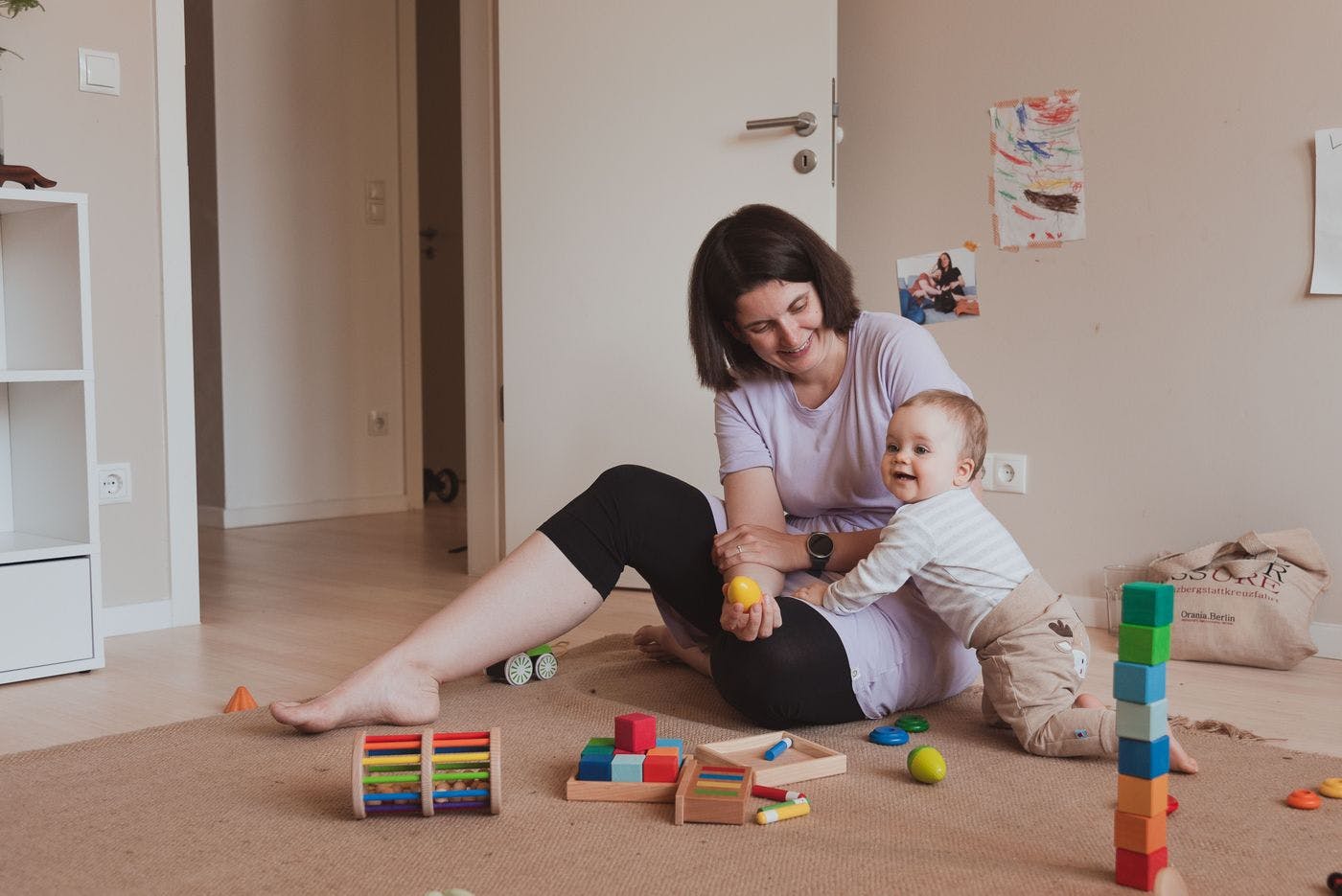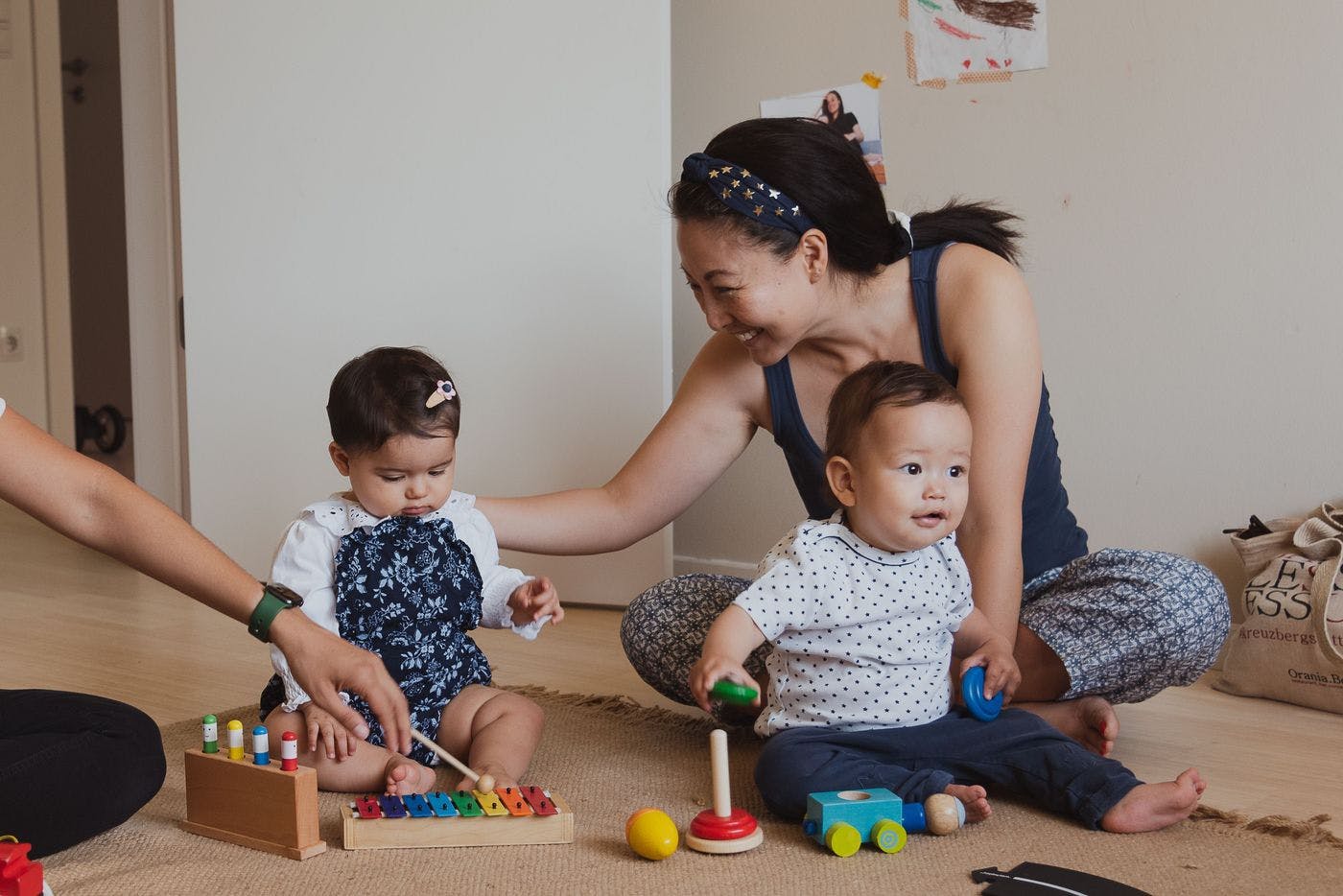
What babies learn from month 12 - 18 months
Baby Development: The Baby from 12 to 15 Months
What your baby learns at 12 to 18 months
Your baby becomes a toddler during this special time. Your child’s strong need for independence coincides with her vastly improved language and gross motor skills. Improved fine motor skills and concentration allow your child to spend many enjoyable hours engrossed with fun and challenging toys. Tribu’s Duck and Deer boxes contain the best toys for your 1 year old that promote movement, coordination, and sensory perception and satisfy the urge to explore.
Baby Development – 12 to 15 Months: Walking, Speaking und Exploring
Congratulations to you and your baby: one year old! What a fantastic achievement! You’ve both learned a lot this past year, and are now feeling more confident, competent, and eager to explore and pick up new skills. Continue to be your baby’s first teacher, it loves learning from you!
In months 12 to 15, your little one is making major progress in terms of movement. Your baby is eager to walk, and may be holding on to furniture, a walk wagon, or a parent’s legs for stability as she cruises around. Some children are even walking independently at this time. Either way, your child is on the path to becoming a skilled walker. Time to explore!
Your baby’s hand movements are also more refined. Your little one can now grasp with its finger and thumb and enjoys opportunities to exercise fine motor skills and hand-eye coordination. Toys that feature opportunities to exercise hands and strengthen wrists are important at this age. A practical activity like pouring water is a great and enjoyable challenge for your child.
Your baby’s language skills make a huge breakthrough: your little one will say its first intentional word. So exciting! Your child can understand more brief and familiar conversations and is enthusiastically soaking up new vocabulary–even if it may take longer before she can say all the words herself. Your baby will want to know the names of objects around her and in books. Some children at this age also use nouns, verbs, or adjectives in 1 to 2 word groupings. In any case, your little one is becoming more communicative and engaged with your family and people around her.
Your baby is swiftly approaching toddlerhood and is eager to express her growing confidence and personality. Here are 5 Montessori tips to help you keep up with this exciting individual:
- Maximum Effort
Ever notice your child pushing furniture across the room or lifting a very large cushion? This is your child’s brain urging her to challenge her coordination and gross motor skills. Find safe opportunities for your child to practice her strength and skills. - Help Me Help Myself: The Journey to Self-Discovery
Your self-confident child wants to do more things independently. Support your child by giving them chances to complete daily activities on their own. Try adding a low shelf for their items, assign a low drawer for your child’s dishes, designate a carpet or area for their playtime use, and give them easy access to their own toothbrush and water cup. Your child will be proud to practice these activities solo. - Freedom and Responsibility
Teach your little one that along with freedom and independence comes responsibility and consequences. For example, your child may have the freedom to walk to the park with you, but has the responsibility to not run in the street. If your child ignores or doesn’t fulfill this responsibility, it will face the consequence of riding to the park in the stroller. Children will test limits on this, so be consistent with your reaction and response. - Concentration, or Not?
Now that your child can move around more easily, it may have a hard time settling into an activity. To help your child develop concentration, minimize the options you present to your child. Don’t interrupt her if she’s concentrating (unless it’s something dangerous, of course!). - Toilet Awareness
Potty training: allow your child to become interested in her own time. Place a potty in the bathroom and a basket of toilet paper squares. Let your child explore. Invite your child to sit on the potty before bathtime, during the day, or before bedtime. This lets your child know the potty or toilet is available to them whenever she is ready to ditch the diapers.
The Duck Box: Educational Toys for Babies beginning at 12 Months Old
Tribu has collected the best toys to stimulate your baby’s development. This is how the toys help your baby beginning at 12 months old:
- The Rainstick is a wooden musical toy that can be used as a rattle, a rhythm instrument, or a sensory toy. It trains acoustic perception with its soothing musical sounds. The dynamic toy is sure to spark your baby’s love for music.
- Chicken Nesting is an open-ended toy that offers a variety of learning opportunities for your little one: hand-eye coordination, sensory exploration, tipping practice, color recognition, size discrimination, tower building, and nesting.
- The Pop Up Toy is beloved by many Tribu babies! This peg box exercises your child’s fine motor skills, hand-eye coordination, grasp, and grip. Your child will also learn vocabulary words for colors. Your baby will love the challenge of putting the pegs back in their slots. Especially fun: the pegs can really POP out of the box which may cause your little one to laugh.
- The Shapes Puzzle is a satisfying first puzzle for your baby. Its indentations are shallow enough that shapes easily fit in, giving your child something to be pleased and proud about. It is made of recycled plastic materials that are soothing for your baby’s touch. It is perfect for training your little one’s hand-eye coordination, pincer grasp, figure perception, and knowledge of geometric shapes.
- The Horizontal Ring Stacker is a special wooden toy that gives your baby a whole new opportunity: horizontal stacking! Your baby is probably used to vertical stacking but this new horizontal stacking challenges your child to strengthen the wrist, develop hand-eye coordination, and count 1-3.
- Sorting Shapes is a simple and beautiful toy that offers a BIG challenge for your fast-learning child. The shapes offer your baby language opportunities and develop its fine motor skills and spatial awareness. Your child will learn to become more familiar with geometric shapes, colors, and hand-eye coordination. This toy features wooden shapes and a recycled plastic base. Your little one will marvel at its lovely colors and enjoy touching its textured surfaces.
- The Coin Box is a cool wooden toy that simulates your baby’s first piggy bank! Its large baby-safe coins give your child the opportunity to practice concentration, patience, and hand-eye coordination. It also features a drawer that your little one will love to open and shut.

The toys of the Duck Box.
Baby Development – 15 to 18 Months: Independence and Responsibility
Your toddler continues to become more independent. In months 15 to 18 months, your little one is repeatedly exercising a variety of gross motor skills: walking, throwing, running, jumping, riding, dangling, pushing and pulling, climbing stairs, and sliding. Go, go, go!
Your toddler continues to develop hand movements, and has increased capacity for concentration and focus to practice certain motions and activities repeatedly. Your child can comfortably sit at a low table and chair now. More than ever, toys that feature opportunities to exercise hands and strengthen the wrists are important at this age.
Your toddler’s language skills continue to explode and you can understand your child even better. This is great, because your little one is highly interested in expressing her needs at all times!
Self-care and practical life activities are great opportunities for your child to gain further self-confidence and independence. Hand washing, mopping up spills, opening and closing containers, and preparing simple snacks are great small jobs for your little one.
Your toddler is exercising newfound independence and increased communication skills. Here are 5 Montessori Tips to help you keep up with this busy little person.
- Sharing
Your toddler naturally has a difficult time sharing. As a parent, model what sharing looks like using food and activities that you’re doing. Treat your child respectfully. Imagine this: if you were reading a book and a friend said, “share!” and plucked the book out of your hands, you’d likely be offended and find the behavior rude. This is how your toddler perceives it. Keep this in mind when modeling sharing with your child. - The Power to Say “No” and the Power to Change One’s Mind
Your child loves saying “no!” and you should respect that. It feels good to have this little bit of power. Your child also loves to change its mind. If you offer a child a snack and she says “no!” just respond by saying, “All right, I’ll leave the snack over here if you change your mind.” Maybe she’ll grab the snack and eat it then – only because it was her choice! And you’ve done a good thing as a parent acknowledging her wishes. - Modeling Manners
Set an example by modeling good manners yourself. Say “thank you” and “please” all the time and your child will catch on. It’s far more effective than prompting and nagging her to say it. - Pushing the Limits
Sometimes toys have too many parts and can make your child feel overwhelmed. Help out by simplifying the activity or reducing the number of parts needed for play. Later, gradually increase the number of pieces and complexity to suit your child’s needs. - Observation
Take 15 minutes every once in a while to stand back and observe your child. Your child is learning and changing so fast, it’s important to take notice of what your child is most interested in, what toys she’s using and what household items she’s interested in. Determine if she needs more physical challenges and what level of mental stimulation (too much, too little?). Think of new activities or objects to add to or rearrange in your home.
The Deer Box: Educational Toys for Children beginning at 15 Months Old
Tribu has curated a variety of beautiful and educational toys to assist with your child’s development. This is how the toys help your child beginning at 15 months old:
- The Push and Pull Walker is a wooden toy that is great fun for both walking and not-yet-walking children. Your toddler can practice pushing it while walking forwards and backwards and can also pull it along behind them–all great for promoting balance and coordination skills! The gentle rattle of the toy gives auditory feedback on your child’s movement.
- The Climbing Man is a mesmerizing wooden toy that trains your child’s grasp and release skills, tracking, and concentration. It helps your child practice patience as they wait in anticipation for the little red man to reach the bottom of the ladder.
- The Curved Stacker (also known as the “Wooden Horizontal Curved Dowel”) is a wooden toy that helps strengthen your child’s wrist, stimulates hand-eye coordination, develops grasp and controlled release of the grip, concentration, and refines coordination of movement. These are all skills that will come in handy later when your child learns to write.
- The Nature Stacker is a beautiful wooden toy that has so much to offer. It can be used for sorting, Lego-like construction, color matching, language learning, and imaginative play. Its colorful and playful design invites sensory exploration!
- The Clapper is a clever wooden toy that gives your child the chance to practice a new kind of movement: alternating hands up and down, similar to milking a cow. This has many benefits: left-right brain lateralization, gross motor development, sensorial exploration, and following rhythm. The toy produces a pleasing click-clack sound which supports the need, love, and respect for instrumental music.
- The Geometric Form Puzzles are dynamic Montessori puzzles that are the perfect challenge for your little one who is experimenting with geometrical shapes that she sees everyday. This toy will grow with your child and presents many levels of difficulty, starting with the cylinder and ending with the triangular prism. This set of wooden puzzle toys encourages vocabulary development and is sure to keep your child occupied for months of fun and learning!
- The Animal Puzzle is a wonderful first puzzle for addressing the concept of parts-of-a-whole. The familiar and fun cats and dogs shapes will give your child the opportunity to compare and discuss size, develop grasp, and refine hand-eye coordination. Your little one will love the sensorial feel of the pieces which are made entirely out of recycled plastic. This is a lovely toy that is pleasing to the eye and to touch.

The Deer Box toys.
 Written by Karen Simon
Written by Karen Simon






